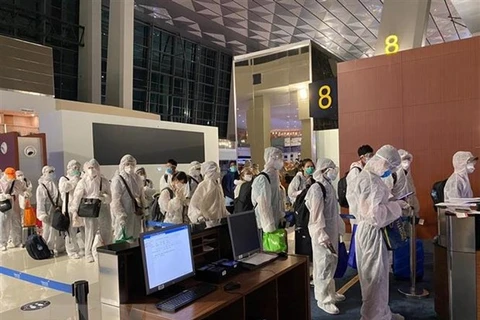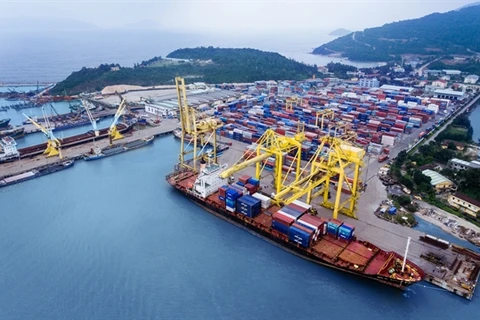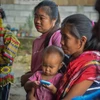 Workers at ITM Vietnam Limited at Vietnam-Singapore Industrial Park (VSIP) in Tu Son town, Bac Ninh province (Photo: VNA)
Workers at ITM Vietnam Limited at Vietnam-Singapore Industrial Park (VSIP) in Tu Son town, Bac Ninh province (Photo: VNA) Hanoi (VNA) – Vietnam has been depicted by foreign media as a bright spot among Asian economies thanks to the country’s success in balancing the efforts to protect the public health and maintain economic growth right from the beginning of the COVID-19 pandemic outbreak.
The Manila Times of the Philippines has recently run a story highlighting Vietnam’s success in dealing with the COVID-19 crisis, and analyzing the reasons why the Vietnamese economy has managed to catch up with the Philippines’ economic development in recent decades.
The article noted that as the pandemic spreads in the whole globe, many leading economies such as the US, Germany, Canada and Japan or Asian countries have faced big problems in economic development.
The Vietnam miracle
According to The Diplomat, due to the economic downturn unleashed by COVID-19, the number of poor people in the region is set to rise for the first time in 20 years, with up to 38 million people falling back into poverty by the end of 2020. This increases the number of Asians living below the poverty line to 517 million.
In its recent report, the World Bank conservatively estimated that GDP collapse in 2020 could be at 6.1 percent in Malaysia, 9.9 percent in the Philippines, and 10.4 percent in Thailand. Together, the ten members of the Association of Southeast Asian Nations (ASEAN), excluding Brunei and Singapore, could register a GDP contraction of 4.7 percent in 2020.
The World Bank report noted that the hardest hit economies are those affected by the global collapse in tourism and exports, and those that continue to grapple with serious outbreaks of the disease, including Indonesia, the Philippines, and Myanmar.
The only seeming bright spot in Asia is Vietnam, which ably balanced public health and economics right from the onset of the pandemic. The World Bank expects Vietnam to grow by 2.8 percent in 2020, even as its Asian neighbors struggle to recover from the ongoing crisis.
Takashi Nakano and Tomoya Onishi, wrote in Nikkei Asia, that Vietnam has succeeded in keeping the virus under control. Rising exports have also helped to drive growth, as companies relocate production from China. Exports grew 9.9 percent in October to 26.7 billion USD. In 2019, Vietnam’s export of goods constitutes 100.9 percent of its GDP, while Philippine export of goods was at 14.2 percent of GDP.
When the coronavirus struck, Vietnam was able to keep its impact to the minimum. According to the Ministry of Health of Vietnam, as of December 6, the country had seen 1,366 COVID-19 infections, including 1,220 patients recovered. Fatality was kept at 35.
After only three weeks of lockdown in April, Vietnam resumed manufacturing activities, faster than other countries did in the region. It was strict in implementing health protocols and implemented granular lockdowns only in truly hot areas. As a result, job losses were few, and consumer spending (which accounts for 70 percent of GDP) remained solid.
The IMF projects that Vietnam’s per capita GDP of 3,498 USD will eclipse the Philippines’ 3,373 USD in 2020. It took Vietnam four decades to overtake the Philippines in this aspect.
“Key” to success
Perhaps, the key to the Vietnamese success in the ongoing crisis is how it famously responded to the pandemic in order to keep its economy growing.
Sonny Africa, Executive Director of Ibon Foundation, said that there is of course a lesson here to greatly improve the country’s pandemic response. The deeper lesson, though, is looking at why Vietnam was able to catch up with us to begin with. Its rapid and sustained economic growth doesn’t actually come from simply opening up its economy and seemingly embracing the free market.
Africa contrasted Vietnam and the Philippines, saying that foreign investment is seen as a means to national development and not, as in the Philippines, an end in itself.
Therefore, the economic growth of Vietnam has been more broad-based, robust and sustainable. The extent to which it has been equitable is another set of issues entirely.
During the past three years, Vietnam had foreign direct investments (FDIs) twice that which came our way. In 2020, before the Regional Comprehensive Economic Partnership (RCEP) was forged and before the exodus of manufacturing hubs from China to Vietnam started, FDI pledges to Vietnam was estimated at 38 billion USD, compared to 7.7 billion USD to the Philippines.
On November 15, 2020, the Regional Comprehensive Economic Partnership (RCEP) agreement was signed by 15 member nations. Immediately, several foreign firms moved to Vietnam to bolster their production capacity.
Yu Nakamura, a staff writer of Nikkei Asia, wrote that Foxconn, formally Hon Hai Precision Industry, plans to expand production in Vietnam, with an investment of around 270 million USD. The Taiwan-based company just began the production of liquid crystal displays in Vietnam. It will soon establish a new local company in Vietnam, likely to produce PC-related parts and receive the benefits of the free trade framework.
Young Liu, Foxconn’s chairman, said that the investment fever in Vietnam by major businesses is already quite considerable./.
























